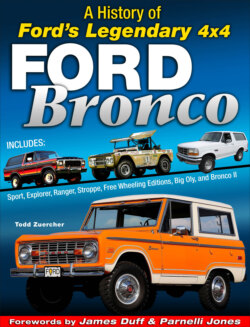Читать книгу Ford Bronco: A History of Ford's Legendary 4x4 - Todd Zuercher - Страница 22
На сайте Литреса книга снята с продажи.
Transmission
ОглавлениеThe 1966 Broncos used 3-speed manual transmissions with a shifter mounted on the column, a configuration used on the F-Series pickups at the time. Because the remainder of the segment vehicles used floor-mounted shifters, Ford touted the column shifter as a plus that gave more seating room for front-seat passengers. Consumer reaction was mixed, and Hurst introduced a floor-shift conversion within a year of the Bronco’s introduction that proved to be very popular with Bronco owners for many years.
The 6-cylinder 3-speed, known as the RAN, had ratios of 3.41, 1.86, and 1.00:1. When the 289 V-8 was introduced, an almost identical transmission with slightly higher torque capacity, known as the RAT, was used. First and second gears had slightly higher (lower numerically) ratios of 2.99 and 1.75:1. Because the engines were different lengths, the cast-iron adapters were of differing lengths so the transfer case and transfer case crossmember could stay in the location in the vehicle regardless of the engine and transmission.
Recently, a retired Ford engineer revealed in an interview that he was responsible for the redesign of the adapters after the initial configuration failed during testing right before the vehicle’s introduction. The engineer noted with a wry smile that he received “lots of help” in the redesign.
The 6-cylinder 3-speed transmissions were backed by a 9-inch-diameter clutch with a 9.375-inch unit as a heavy-duty option. The 289 3-speed had an 11-inch clutch between it and the engine.
